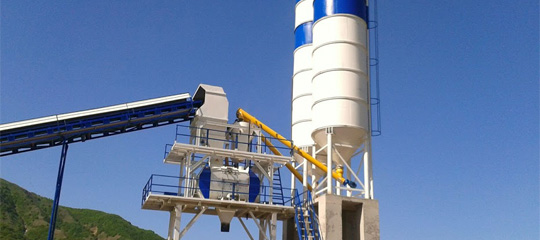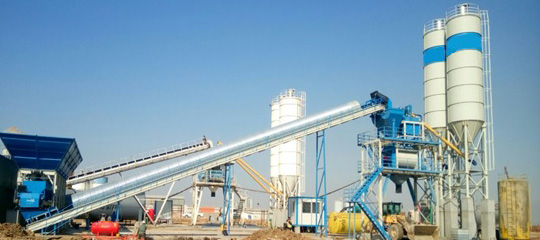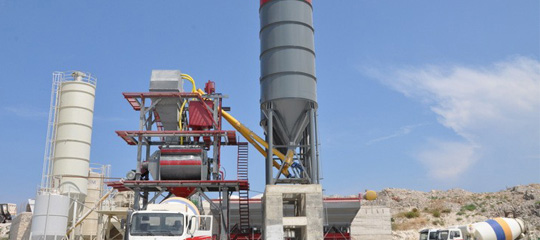Stationary Concrete Batching Plant
Fixed concrete batching plants; It is used to mix components such as sand, stone and cement by combining them with water and to manufacture concrete. When we look at the equipment that makes up these systems that mix the materials used in concrete production, these are; feeding band, concrete beater, aggregate bunker, aggregate weigher, aggregate bucket and cement silo.
There are many different concrete batching plants and stationary concrete batching plants are used in larger projects for a long time. Different concrete batching plants can be preferred for shorter projects. Stationary concrete batching plants, which minimize the work to be done on site during the installation of the concrete plant, consist of two parts, the main chassis and the aggregate bunker, and are easily installed. Thanks to its structure, it makes loading easier.
Fixed Concrete Batching Plant: Automation Systems
By using the automation system in the facility where the production will be made, operations such as dosing, process monitoring, production reporting, order management, production planning, stock control, truck scales, quality control, truck scales can be performed automatically. Various concrete mixture formulas are loaded into the system in line with the desired properties and automatic dosing is provided by these automation systems.
In automatic dosing, the production command is given after the concrete mixture formulas are loaded into the system, and in this way, materials such as cement, aggregate, additives and mixing water in the required amount according to the desired mixture formula are automatically weighed and mixed.
Fixed Concrete Batching Plant and Other Vehicles
The transmixer in the stationary concrete plant is a truck-like vehicle used to transport the fresh concrete to the desired location without deterioration. Due to its ready-mixed concrete structure, if it is not used within two hours, it may deteriorate. The transmixer used to prevent this situation is one of the indispensable tools in ready-mixed concrete plants.
Ancillary vehicles used in ready-mixed concrete plants other than the stationary concrete batching plant, transmixer and automation systems are production vehicles such as pumps and vibration. A pump is used to transfer the concrete material to the mold without pouring it, and a vibration system is used to fill the air spaces of the concrete after it is poured into the mold. It is essential to use such tools in order to produce high quality ready mixed concrete.
Types of Fixed Concrete Batching Plants
Fixed concrete batching plants, which are systems that provide high production capacity in long-term projects, are used for production in a certain area.
High efficiency can be achieved with these concrete batching plants, which offer comfortable usage areas, especially in large areas. It should also be taken into account that it is not possible to relocate them like other concrete batching plants. Fixed concrete batching plants require site layout.
There are 4 different models in fixed concrete batching plants: 60 cubic meters, 100 cubic meters, 120 cubic meters and 160 cubic meters. Stationary concrete batching plants, which differ in mixing type, mixer capacity, cement silo, cement spiral, engine power and water weighing capacity, are used for different needs.
Technicial Specification by Types
In its model, which has a production capacity of 60 cubic meters per hour from stationary concrete plants, it can carry up to 40 tons of cement without a silo. Total engine power is 130 kW and electric generator requirement is 200 kW. Mixer options include single-shaft, double-shaft and planetary mixers. The area required to operate this stationary concrete plant is 700 square meters. Single shaft mixers are used to ensure the required homogeneity and workability in modern concrete mixtures. Single shaft mixers, which are resistant to abrasion thanks to their special alloys, can also be used in different applications such as grinding concrete mix, coal or other mines.
- The volume of the aggregate hopper is 4×20 cubic meters.
- The weighing chamber has a capacity of 1.5 cubic meters and is 800×13000 mm in size.
- While the aggregate transfer conveyor is 800×25000 mm, the aggregate waiting chamber is 1.5 cubic meters.
- Mixer wet concrete volume is 1 cubic meter.
- The cement weighing chamber has a capacity of 600 kg, the water weighing chamber has a capacity of 300 liters and the additive weighing chamber has a capacity of 20 liters.
- The air compressor has a capacity of 300 liters and an engine power of 5.5 kW.
- Cement silo is between 50 and 500 tons capacity and is optional.
- The control type is fully automatic.
The stationary concrete batching plant with a production capacity of 100 cubic meters per hour can take up to 50 tons of cement in weight. Total engine power is 180 kW and electric generator requirement is 250 kW. As in the 60 cubic meter stationary concrete plant, mixer options are single shaft, double shaft and planetary mixers.
- The aggregate hopper volume is 4×25 cubic meters.
- The aggregate weighing chamber is 1.5 cubic meters and its dimensions are 1000×13000 mm.
- Aggregate transfer conveyor has dimensions of 800×28000 mm.
- The aggregate holding chamber is 13 cubic meters.
- Mixer wet concrete volume is 2 cubic meters.
- Cement weighing chamber is 1200 kg, water weighing chamber is 600 liters and additive weighing chamber is 30 liters.
- The air compressor has 500 liters and 7.5 kW engine power.
- Cement silo is between 50 tons and 500 tons.
The weight capacity of the stationary concrete batching plant with a production capacity of 120 cubic meters per hour is 60 tons without cement silos. Total engine power is 205 kW and electrical generator requirement is 300 kW. In the mixer options, there is only a double shaft mixer. The area required to operate this power plant is 750 square meters.
- The aggregate hopper volume is 4×30 cubic meters.
- The aggregate weighing chamber is 4.5 cubic meters and its dimensions are 1000×13000 mm.
- The dimensions of the aggregate transfer conveyor are 1200×30000 mm.
- The aggregate holding chamber is 4.5 cubic meters.
- The wet concrete volume of the mixer is 3 cubic meters.
- Among the weighing chambers, the cement chamber is 1800 kg, the additive chamber is 50 liters and the water chamber is 1000 liters. The air compressor is 500 liters and has an engine power of 7 kW.
Finally, the weight capacity of fixed concrete plants with a production capacity of 160 cubic meters per hour is 70 tons without cement silos. Total engine power is 250 kW and electric generator requirement is 350 kW. In the mixer options, there is only a double shaft mixer, as in the power plant with a capacity of 120 cubic meters. The space required to operate is 850 square meters, which is a larger size than the others.
- The aggregate hopper volume is 4×40 cubic meters.
- The aggregate weighing chamber is 6 cubic meters and its dimensions are 1200×13000 mm.
- Aggregate transfer conveyor is 1200×32000 mm.
- The aggregate holding chamber is 6 cubic meters.
- Mixer wet concrete volume is 4 cubic meters.
- Cement weighing chamber is 2400 kg, water weighing chamber is 1200 liters and additive weighing chamber is 100 liters.
- The air compressor has a capacity of 1000 liters and a power of 11 kW.
- Cement silo has a capacity between 100 tons and 500 tons.




